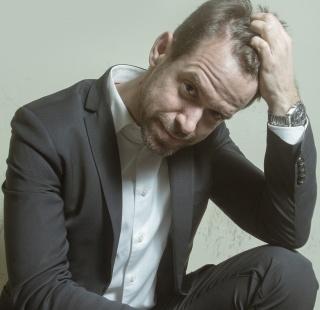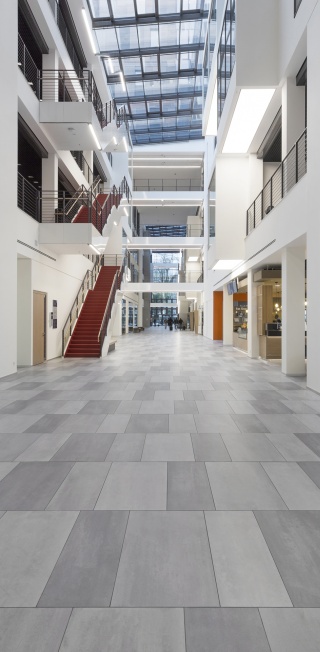
Looking for a new location
The financial heart of Germany, with strong traditions in science and education and an international focus: Frankfurt has it all. The Frankfurt School of Finance & Management neatly fits into this picture. Having started out as the ‘Bankakademie’ (Banking Academy) seventy years ago, the Business School is now one of the most renowned universities for Banking, Finance, and Management in Germany. The Business School has been steadily growing over recent years, and the campus was becoming too small for the dynamic development. Consequently, the team began looking for a new location and a new building that could fulfill several requirements at the same time – no easy feat.
Very carefully
In cooperation with the city government, the Frankfurt School decided to move to Adickesallee, a central location in the northern part of Frankfurt. The location was chosen very carefully. It allowed the integration of the Business School into the so-called ‘Campusmeile’ (campus mile), which forms an axis starting at the Goethe University, passing Frankfurt School and the German National Library, and ending at the University of Applied Sciences. Secondly, the location has a traditional link with finance as well. The building that stood here before was the Oberfinanzdirektion, the main regional financial government body. This old building featured a facade made of split tiles in different shades of red. The colors seemed to change depending on the light and the angle. At the end of 2014, this building was torn down.
Photography Sem Shayne / Gregor Ramaekers
Mosa tiles were also
used for the interior.
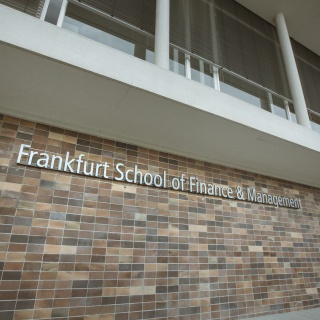
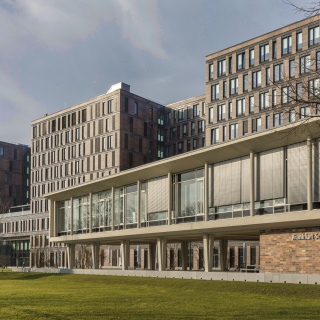
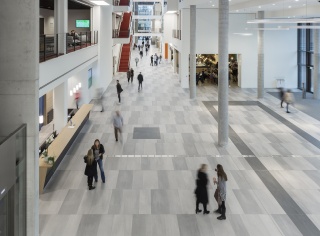
Architectural competition with a complex task
The team at the Frankfurt School decided to hold an international architectural competition to find the right solution. The task for the competition was a complex one, requiring several different aspects to be addressed.
First of all, there was the practical aspect. The new building needed to be able to house everyone working at the Business School: professors, students, and other staff. Student residences also needed to be incorporated, creating a strong campus life – something that wasn’t possible in the old setting of the school.
The second aspect was the learning environment. Rather than building classical classrooms, the aim was to enable learning and teaching in a very open and cooperative forum. Communication, exchange, and cooperation were the key words that needed to be represented by the interior layout. At the same time, the university’s international focus needed to be represented.
Thirdly, the design needed to create a link between the old building of the Oberfinanzdirektion that had stood there before, so that the new building would be the next step in a historical development. As the old Oberfinanzdirektion had a truly unique look, this was quite a challenge for the participants in the competition.
Last but not least – as sustainability is an important topic for the Business School as well – the materials used had to be environmentally friendly.
Only architects with international experience and expertise in designing educational buildings were invited to enter the competition.
A clear reference to the old building
In the end, Henning Larsen architects from Copenhagen emerged as the competition winner. Their design convinced the team, as it combined the history and tradition of the old building with the dynamic, international approach of the Business School today. Henning Larsen therefore became the lead architect. MOW architects also contributed to the project, as they were in charge of managing and planning the new campus project. One key element in the combination of history and tradition with dynamism and an international outlook was the facade: Henning Larsen’s design featured a red tile facade which was a clear reference to the old building. The international aspect is addressed by the five towers, each representing a continent. Inside, the building is characterized by the so-called ‘Zeil des Wissens’ (Street of Knowledge). This canyon-like space between the towers is a central meeting point for everyone. All the main function rooms such as the main auditorium, the learning center, the restaurant and deli as well as the student and alumni relations offices, seminar rooms, and learning rooms, are connected with it. The Zeil des Wissens draws inspiration from the main shopping center in Frankfurt and transfers it into educational context.
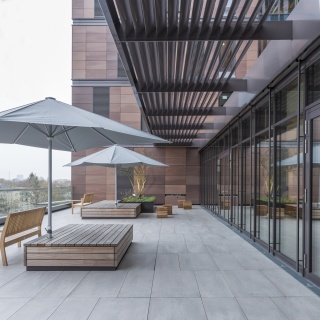
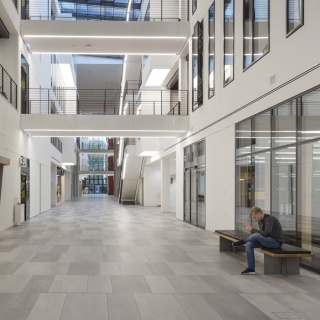
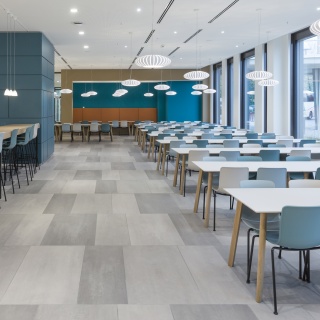
Werner Frosch, Partner and Managing Director of Henning Larsen’s office in Munich, sums up his idea for a modern educational building. ‘Our goal for the building was to create a space with a very inspiring atmosphere in which people can work and meet up. The building gains a lively character thanks to its users: people go in and out, studying, working, reading a book, and communicating with each other. The main atrium, Zeil des Wissens, is a space that truly caters for students and employees. It is a place for working and studying, but also for holding parties and for dancing. Today, students no longer work at home. They go to the university simply to be in a social setting. And, as learning takes place through the knowledge passed on between students in informal social interactions, a university has to provide a framework for that. At the Frankfurt School of Finance & Management, we offer a vast array of lecture rooms: from the traditional large lecture theater to intimate seminar rooms in Harvard style and open teamwork settings, all are connected to the Zeil des Wissens to help encourage natural human curiosity, making contact and starting a dialogue.’
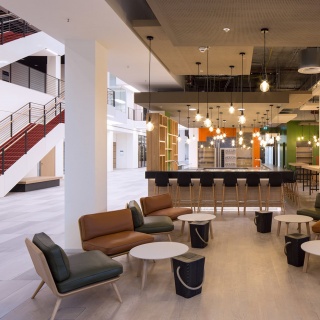
The school caters for a
strong campus life.

‘The Frankfurt School is a dynamic organization. This dynamism is represented in the colour play. The facade has become part of our branding.’
History and future combined: the facade
Although Frosch’s idea of a university is quite modern and forward-looking, he paid particular attention to integrating the building’s history into the new building. One central element of this is the facade. Professor Dr Nils Stieglitz, President of the Frankfurt School, emphasizes the relevance of the facade: ‘The facade is our calling card; it has a significant influence on the whole building. Our aim was to make it something very special – not too dark, not boring, but also being able to integrate into the surroundings and prolong the history of the building.’ Klaus Ringsleben, Building Director of the school, was highly involved in finding an appropriate solution. He contacted facade suppliers and material manufacturers during a trade fair in Munich. His task was to find the right supplier and the right material – and to focus on sustainability at the same time. ‘We’re aiming for Platinum certification for our campus, the highest possible level.’ For Ringsleben, the challenge was one of aesthetics, technical aspects, and financial considerations. During the fair in Munich, he also came across Mosa and began an intensive dialogue with the company. Together with some colleagues, Ringsleben visited the tile factory in Maastricht and launched in-depth discussions with the designers at Mosa. ‘We were very impressed during our visit. The dialogue always focused on both the aesthetic expression that we wanted to see on the building and the technical solutions that Mosa offers. What really convinced me about Mosa was the company’s history, its organic development, the wide range it offers, and its drive to achieve an architecturally-appealing solution.’
Before discussing a solution with Mosa, the original design idea of Werner Frosch was actually at risk of being shelved because all other solutions were either too expensive or didn’t work in terms of sustainability.
Close cooperation for a common goal
The ideal solution for the Frankfurt School was achieved only thanks to the very close and efficient cooperation between everyone involved. Mosa, Werner Frosch, and Klaus Ringsleben worked as a team of three partners as well as in direct contact with each other as required by each task within the project. It meant very detailed work, creating the appropriate colors, finding the right solution for attaching the tiles to the facade – and last but not least, making sure that everything fit into the overall design concept.
The color was a key factor in the design process. In consultation with Mosa, a unique tile color was developed to echo the traditional red colors of the original building. It took the partners several rounds of color mixing to find the definitive tones. The design team in Maastricht prepared samples and experimented with different tones of red. Following several rounds of development and intensive dialogue between the architects, the team at the Frankfurt School, and Mosa, the result was the ‘Core Collection Solids’ tile in Terra Tones with a size of 36 in. x 36 in. Finally, three different shades of red tiles were chosen. Those tiles were unique in terms of color, design, and size.
Today, they make up the facade. The overall effect of the building comes from the color design and the interplay of the colors, as well as from the interplay of the light and the different atmospheric effects created in the facade. During the day, the look of the facade constantly changes. It is never the same; it is always full of life.
Such close cooperation between architect, client, and manufacturer is not a standard procedure. In the beginning, there was no manufacturer who could supply the tiles directly from their existing portfolio. Mosa took on the challenge and developed something entirely new.

‘Our goal for the building was to create a space with a very inspiring atmosphere in which people can work and meet up.’

‘The interplay between aesthetics and technology as well as cost-effectiveness has to be regarded as a trinity.’
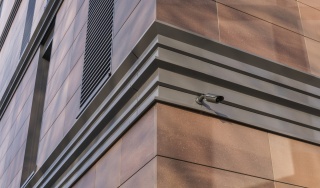
Klaus Ringsleben also highlights the technology behind the facade: ‘I was particularly impressed by the detailed solution for attaching the ceramic tiles to the facade and creating corner solutions and precise joints in the substructure using those tiles. These are details that a casual observer might not spot right away, but which certainly dominate the overall look.’
Viewing the project from Mosa’s perspective confirms how special this project was. On the one hand, the project time was very short: it took just one year to complete the entire project. On the other hand, it was a very large-scale project involving a lot of people. The first step was to ensure that Mosa would be able to fulfil the German technical requirements for the certification of the facade. Having secured this, the project ran very smoothly. Bert Prevoo, Technical Sales Engineer, sums up his impression during the project. ‘Despite being a really large-scale project, it all went very smoothly. The communication between the parties was open and respectful. It was important to have everyone working in the same direction, even though every member of the team had their own ideas. I wish every project could run like this.’
Key factor: Sustainability
Lastly, besides design and the appropriate technology, the Frankfurt School always retained a strong focus on sustainability. The school relied on a certification consultant to gain its Platinum certification.
In Mosa, the Frankfurt School found a partner with the same philosophy. As Mosa has incorporated sustainability as one of its core values, there was no issue. With its Cradle to Cradle Silver certification, Mosa was able to rely on existing processes to fulfil all requirements. The standard procedures were used for the custom-made tiles, so the team at Mosa could fully concentrate on the design process and didn’t have to worry about different standards for raw materials or production processes. With this approach, Mosa was able to make a positive contribution to the Frankfurt School’s efforts in this area.

'From a teaching perspective, the new building offers space to adopt creative teaching methods. It creates many opportunities to meet.’
Aesthetics and technology, history and dynamism
Looking back on the project as a whole, Klaus Ringsleben highlights three aspects and how they are closely linked together. ’The interplay between aesthetics and technology as well as cost-effectiveness has to be regarded as a trinity. The solutions offered by Mosa were well balanced in this respect, especially for our structure.’ In the end, the decision to use Mosa tiles – not only for the facade, but also for the exterior flooring and the interior of the building – seemed a logical step for everyone concerned. It extended the impression from the exterior to the interior, thus contributing to the overall philosophy of the building.
Nils Stieglitz is completely satisfied with the result of this project. ‘It was hard for me to imagine how the whole facade would look when I saw the tile samples that Mosa had produced, but they guaranteed that it would work.’ Now, the colors of the tiles seem to change with the changes in daylight. ‘The Frankfurt School is a dynamic organization. This dynamism is represented in the color play. The facade has become part of our branding. From my perspective, the whole building conveys a pleasant seriousness. This new building is exactly what we hoped for: built on the foundations of our history and looking into a dynamic future. What more could I have hoped for?’
According to the Cradle to Cradle Products Innovation Institute, Cradle-to-Cradle materials are applied with respect for their intrinsic value and their useful afterlife in recycled or even ‘upcycled’ products, which have a value and technological sophistication that may be higher than that of their original use.
Project details
| Project: | Frankfurt School of Finance & Management |
| Architect: | Henning Larsen Architects |
| Location: | Frankfurt (Germany) |
| Completion: | 2017 |
| Mosa series: | Terra Tones, Core Collection Solids |
Inspiration
More information
We set high standards for the advice and support. This means that we actively aim for dialogue and that we are interested in what interests you. Do you have any questions about this project or would you like to discuss the options for your project?
Contact Mosa